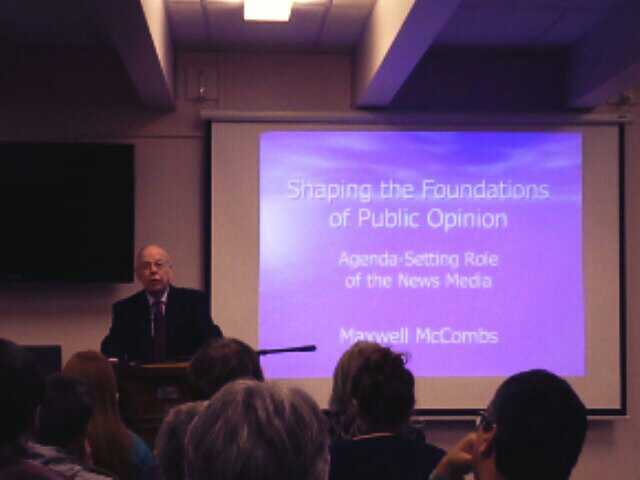
Maxwell McCombs, thought leader in agenda-setting theory and debatable father of modern mass communication, gave a lecture today at my alma matter, Linfield College. The following is a summary of what I learned.

Agenda-setting theory states that the mass media influences what the public thinks about. The elements that are prominent in the news become prominent in the public mind; hence, transfer of salience. McCombs recommends anyone interested in the topic to read Public Opinion (1922) by Walter Lippmann.
There is a large background of research that supports the theory. A little background on the process; content analysis is used to decipher the media agenda (ex. scanning the newspapers for key terms to determine the most discussed topics), and the public agenda is discovered via survey. A commonly asked question goes something like “What do you think is the most important issue facing the country today?”
Basic agenda-setting effects
- Focusing public attention
- Expanded media language
- End of agenda vs. stronger effects
There has been no significant change in the agenda setting role of the media.
Adults ages 18 to 34 tend to be less influenced by media agenda, possibly because they tend to read newspapers less and rely on other sources (Internet, social media) for their news. They tend to have a slightly different issue agenda, not the same as the daily news on TV.
Studies that looked at major newspaper agenda in Louisiana and North Carolina found that there was a 1.0 positive correlation between the public agenda (ages 35 and older) and media agenda.
Not incredibly surprisingly, the correlation wasn’t only found with the topics, but the rankings of the topics.
Introducing social media into the mix
- Online and traditional news channels often complement each other.
- Twitter reflects traditional media; social media are distribution channels, not where information originates.
- There is overlapping use of media outlets, and redundancy in the media as journalists use each other to stay on top of current issues. Social media makes it much easier for news agencies to “spy” on each other.
- The collective impact of media is more influential than just one channel (ie. a whole network instead of just a website, or just social media).
- Agenda-setting effects happen over time, usually in 4 to 6 weeks.
In conclusion, the three levels of agenda setting…
- Content analysis (salience of discrete elements)
- Attribute analysis (salience of discrete elements)
- Salience of networked elements (“bundles” of information)
Not only are individual topics transferred into public minds, but “ideas” as well.
Limited power of agenda-setting effects
The public can accept of reject the media agenda. Most of the time, the public accepts the majority of the media agenda.
It’s an individual decision, usually based on the perceived relevance of the media agenda.
- Personal relevance: how it affects you, ex. the social security issue to a retiree
- Social relevance: how it affects the environment, not you personally, ex. the environment
Ta-da!